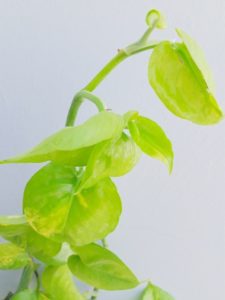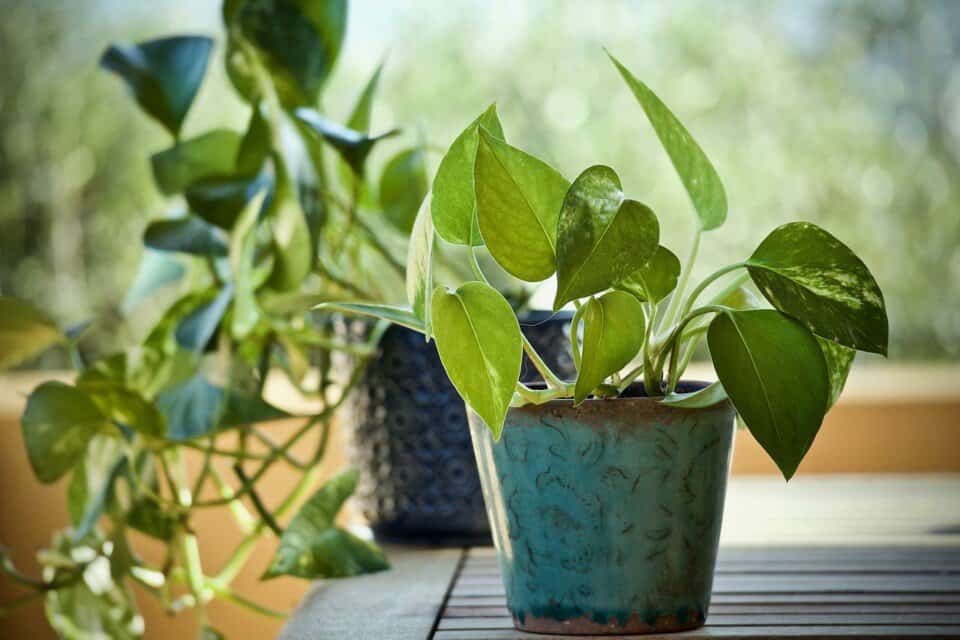Some links in the post are affiliate links and I get a commission from purchases made through some links found in the post.
Although Pothos have the reputation for being easy to maintain and care for, every so often you may find that your Pothos looks like it is dying. This can be alarming to say the least, for any gardener, even an experienced one.
Pothos are classified as climbers and in the right conditions can spread to almost 10’ long. They are known for their beautiful heart shaped leaves and different shades of green.
The Pothos family of plants does best in bright, indirect lighting, preferable in a humid area of between 50-70% as this replicates the tropical environment where they come from.
For your Pothos to look as if it is about to die, there are only a few reasons, and fortunately these are relatively easy to sort out.
Often the reason for the Pothos to look like its dying is due to soil and water issues, although there are some other reasons which may not be as obvious.
One thing to remember is that your Pothos will let you know early on whether it is happy in its environment or not. By paying attention to these signs, you will soon know whether you have a happy plant or one that is battling to survive.
Catching the issue early on will make the recovery quicker and less traumatic for the plant – and possibly for you as well!
Some of the reasons why your Pothos looks like it is dying:
- Overwatering
- Underwatering
- Incorrect temperature
- Humidity issues
- Soil problems
- Potting problems
- Pest invasions
- Sunlight issues
How to Revive your Dying Pothos
1) Overwatering
 Like many other plants, the Pothos does not appreciate being overwatered. Overwatering leads to roots which are constantly soggy and never dry out. This is never a good thing for a plant, an the Pothos is no exception.
Like many other plants, the Pothos does not appreciate being overwatered. Overwatering leads to roots which are constantly soggy and never dry out. This is never a good thing for a plant, an the Pothos is no exception.
Once the roots are rotten or are drowning because of constant water, they will die. Once the roots die, the rest of the plant will soon follow.
How can we fix this?
If your Pothos is suffering from root rot, you need to remove it from the soggy soil as soon as possible. You may need to use your fingers to gently tease the roots apart, cut of any visible signs of rotting and wash the excess soggy soil away.
Then repot your Pothos in fresh potting mix, making sure that it is well draining, and the pot has drainage holes.
Future Precautions
The best way to water your Pothos is to give it a good water and then let it rest until the soil has dried out before you water it again. You may need to change the watering schedule for these plants as their needs are different from other plants.
You should also make sure that the pot has drainage holes in the bottom so excess water can run out. This will stop the roots becoming wet and rotting.
If your pot is placed on a base, make sure that excess water does not remain there for long periods as this will be absorbed back into the pot and the soil will stay damp.
2) Underwatering
Underwatering will show up as droopy leaves and a generally limp looking plant. In many plants including the Pothos underwatering is not as bad as overwatering as many plants can tolerate dryness for short periods of time.
Pothos plants will soon start to droop if they have not received the correct amount of water, and if they do not receive water when needed them can look as if they are dying.
How can we fix this?
If the potting mix is very dry you should give your Pothos a good soaking. Leave the plant raised so the excess water can drain through the soil and out the bottom.
Many new gardeners may start to panic at this point and resort to watering more frequently. This is not a good thing to do as this can take the Pothos into an overwatering situation.
You may also want to gently wipe the leaves with a damp cloth as this will open the pores and remove any particles of dust. Spraying with a water sprayer will add some humidity in the immediate area.
Future Precautions
Set a watering schedule that is suitable for the Pothos. Remember that this may differ from other houseplants you have.
3) Incorrect Temperatures
 In its native environment the Pothos thrives in temperatures between 60-80 degrees F. It will not do well below 50 degrees F. Neither will Pothos be happy in desert conditions. So, try to keep the temperatures as neither too hot nor too cold.
In its native environment the Pothos thrives in temperatures between 60-80 degrees F. It will not do well below 50 degrees F. Neither will Pothos be happy in desert conditions. So, try to keep the temperatures as neither too hot nor too cold.
If you notice that the leaves are turning black and it looks like your Pothos is dying, consider the temperatures as this is a sign that the plant is too cold.
Be aware of air conditioners as these do not make for a happy plant. Blowing very cold air in the room will be fine for humans but is not good for plants.
If you do have an air conditioner in the room where you have your Pothos, then do not place the plant in front of it. Pothos do not enjoy having air blown directly onto them and will become stressed and possibly die.
How can we fix this?
Move your Pothos to a room where there is no rapid movement of air. Do not place it directly under a fan or in front of an air conditioner. If your Pothos looks like it is dying and the leaves turning black, then consider moving it elsewhere.
Future Precautions
Pothos do not like being placed near any draughts, either from air conditioner, fans or even windows which are constantly open. They do not ask too much of us, but draughts are not good for Pothos.
4) Humidity Issues
Your Pothos prefers to be in an area where the humidity is slightly higher than other plants. If it is placed in an area where the air is very dry it will start to wilt and look like it is dying.
In most houses the summer temperatures are acceptable for Pothos but in winter the air becomes drier, and the plant will suffer.
How can we fix this?
Keep a spray bottle filled near your plant and spray the plant a few times a day. This will help to keep the leaves moist.
You can purchase small plant humidifiers which will keep the air moist around your plant.
Many garden centres will stock misters which can be set up at your Pothos to keep the area moist.
Future Precautions
Your Pothos does not do well in dry air so be prepared to spray it several times a day when the air gets dry. If the humidity remains too low for an extended time, your Pothos will likely die.
5) Soil Problems
If your Pothos does not have good soil or potting mix it will start to look like it is dying. Use a high-quality, well-draining potting mix which you can buy from any decent garden centre.
Organic potting mixes are made from natural ingredients and do not contain any chemicals so are better for use inside your home.
If you prefer you can make your own mix by using peat, mulch, organic manure, perlite, and bark. This will give you an option of making your mix as loose or dense as you like.
Ph of the soil is also important for your Pothos. It likes a pH of between 6.1 and 6.5 which is slightly acidic.
A pH of 7 shows a neutral soil, above this are alkaline and below it is acidic. Your Pothos can tolerate slightly higher or lower ranges but too alkaline will not mean a happy plant.
How can we fix this?
You can invest in a pH home testing kit which will show you the levels of the soil for your Pothos.
Future Precautions
Check the pH level of your potting mix before you repot your plant and make adjustments before you plant your Pothos.
6) Potting Problems
 Even if you have good, well-draining potting mix, your Pothos may still look like it is dying. If you see this then look at the pot size.
Even if you have good, well-draining potting mix, your Pothos may still look like it is dying. If you see this then look at the pot size.
Pothos do not like their roots to be cramped and they do not do well if they are pot bound. A sad, droopy Pothos may be caused by the plant being in too small a pot.
If your Pothos is growing outside it will not develop cramped roots as their will be space for the roots to spread.
You can tell if your plant is pot bound you will see the roots growing around the drainage holes at the bottom. Eventually the roots will grow out of the bottom, and this is a sure sign that you need to repot the plant.
How can we fix this?
Prepare a new pot with good drainage holes and fresh mix. Remove the plant from the old pot and gently tease the roots apart. Place in the new pot and add enough potting mix to cover the root ball. Give the plant a good water and leave it to adapt to the new environment.
Future Precautions
It is not a good idea to leave your Pothos in a small pot for too long as compacted roots will cause the plant to die because it cannot absorb enough nutrients from the potting mix.
7) Pest Invasions
Although generally Pothos can tolerate pests, if you have a large infestation it will eventually kill the plant.
Scale and mealybugs are enemies of the Pothos. You can see scale as these are tiny insects which are brown and have hard shells. They attach themselves to plants and suck the sap from the stems and leaves.
You can remove scale by gently rubbing the insects off with an exfoliator sponge. Another way to remove them is to spray them with rubbing alcohol and then wipe them off.
Mealybugs feed on plants and then secrete a substance which encourages mold. Mold will eventually cause the leaves to absorb less sunshine than they need, and the plant will die.
Pothos may also succumb to a disease called Botrytis which will manifest itself in grey, mushy areas on stems and leaves.
How can we fix this?
You should inspect your Pothos for infestations frequently. Anything which looks out of the ordinary or makes your Pothos look like is it dying needs to be checked out as soon as possible.
It is better to be ready for a pest infestation and take care of it right away because it will only get worse, and your plant will die. Having a routine for checking for infestations is a good idea as you will be able to treat any infestations sooner.
Future Precautions
If you see any parts of your Pothos which are badly infected by disease you should prune off the infected area and dispose of it – not in your compost area.
Make it a habit to look at the base of the leaves for tiny insects and treat them right away.
8) Sunlight Issues

Pothos does not do well in direct sunlight. Rather, place it is indirect, bright areas where it receives dappled light.
If your Pothos is getting 6-8 hours of sunlight a day you will see that the leaves turn pale, and the plant becomes limp. Eventually the plant will die.
Conversely, the Pothos will not be happy in a dark area, and it may die. You will see that the leaves lose the variegation and the colour fades. This is a sign that the lighting is not good enough.
How can we fix this?
Do not place your Pothos on a windowsill where it gets direct sunlight through the day. Move it away from the window where the light is bright, but indirect.
Your Pothos will be happy in an area where it gets either the early sunshine or late afternoon rays, but nothing more than this.
Future Precautions
While Pothos can tolerate lighting issues for a short time, they will eventually die if they are in direct sunlight or in a dark place.
Consider the lighting requirements when you bring your new Pothos home or when you repot it. The plant will soon let you know that it needs extra light when the leaves start to fade, and the plant looks like it is dying.
Final Thoughts
In truth, Pothos are easy to care for and maintain, and while your plant may sometimes look as if it is dying, the chances are that you can revive it if you act sooner rather than later.
Pothos are excellent indoor plants and enhance any area, particularly when they are in good health, so it pays to be familiar with the needs of your plant and to adjust things when needed.


